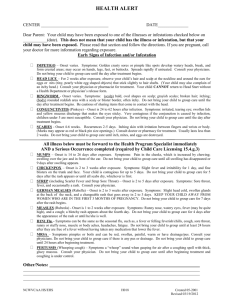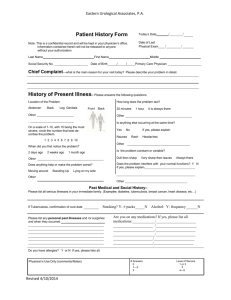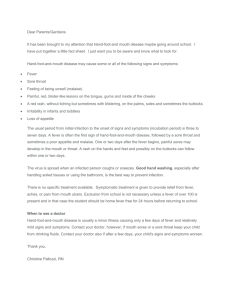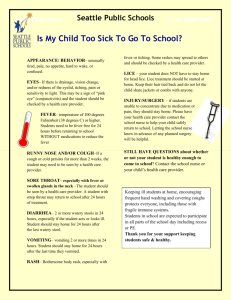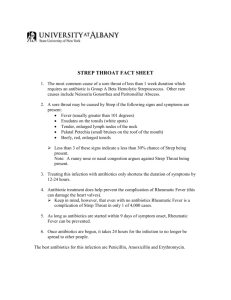H018 Health Alert
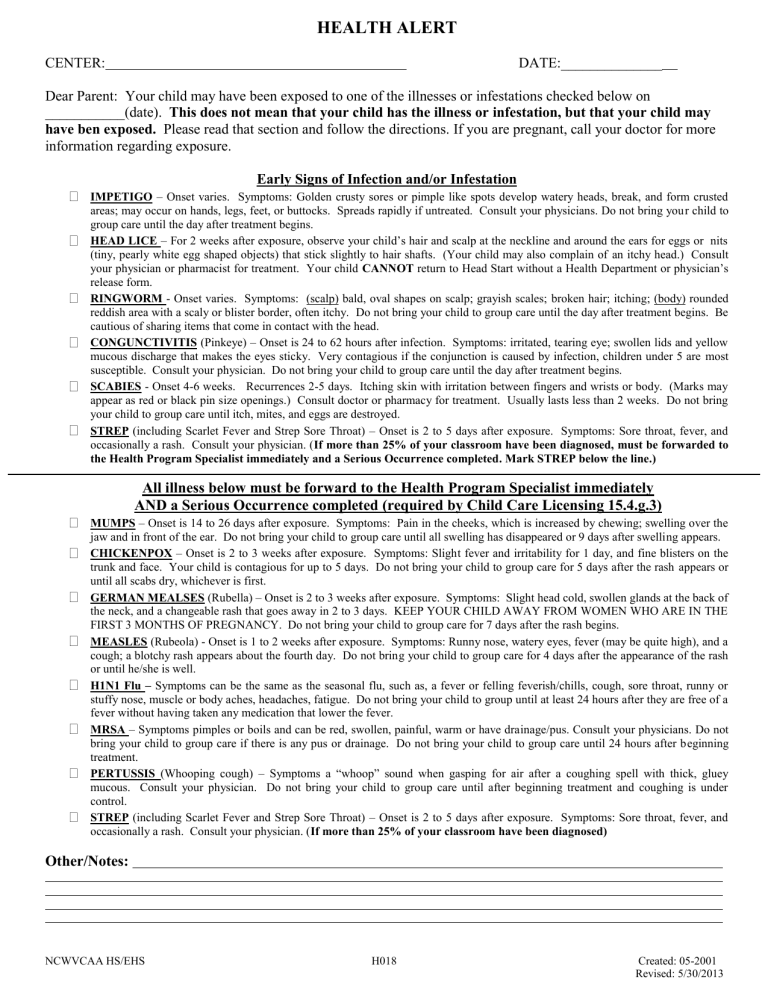
HEALTH ALERT
CENTER: DATE:______________
Dear Parent: Your child may have been exposed to one of the illnesses or infestations checked below on
___________(date). This does not mean that your child has the illness or infestation, but that your child may have ben exposed.
Please read that section and follow the directions. If you are pregnant, call your doctor for more information regarding exposure.
Early Signs of Infection and/or Infestation
IMPETIGO – Onset varies. Symptoms: Golden crusty sores or pimple like spots develop watery heads, break, and form crusted areas; may occur on hands, legs, feet, or buttocks. Spreads rapidly if untreated. Consult your physicians. Do not bring you r child to group care until the day after treatment begins.
HEAD LICE – For 2 weeks after exposure, observe your child’s hair and scalp at the neckline and around the ears for eggs or nits
(tiny, pearly white egg shaped objects) that stick slightly to hair shafts. (Your child may also complain of an itchy head.) Consult your physician or pharmacist for treatment. Your child CANNOT return to Head Start without a Health Department or physician’s release form.
RINGWORM - Onset varies. Symptoms: (scalp) bald, oval shapes on scalp; grayish scales; broken hair; itching; (body) rounded reddish area with a scaly or blister border, often itchy. Do not bring your child to group care until the day after treatment begins. Be cautious of sharing items that come in contact with the head.
CONGUNCTIVITIS (Pinkeye) – Onset is 24 to 62 hours after infection. Symptoms: irritated, tearing eye; swollen lids and yellow mucous discharge that makes the eyes sticky. Very contagious if the conjunction is caused by infection, children under 5 are most susceptible. Consult your physician. Do not bring your child to group care until the day after treatment begins.
SCABIES - Onset 4-6 weeks. Recurrences 2-5 days. Itching skin with irritation between fingers and wrists or body. (Marks may appear as red or black pin size openings.) Consult doctor or pharmacy for treatment. Usually lasts less than 2 weeks. Do not bring your child to group care until itch, mites, and eggs are destroyed.
STREP (including Scarlet Fever and Strep Sore Throat) – Onset is 2 to 5 days after exposure. Symptoms: Sore throat, fever, and occasionally a rash. Consult your physician. ( If more than 25% of your classroom have been diagnosed, must be forwarded to the Health Program Specialist immediately and a Serious Occurrence completed. Mark STREP below the line.)
All illness below must be forward to the Health Program Specialist immediately
AND a Serious Occurrence completed (required by Child Care Licensing 15.4.g.3)
MUMPS – Onset is 14 to 26 days after exposure. Symptoms: Pain in the cheeks, which is increased by chewing; swelling over the jaw and in front of the ear. Do not bring your child to group care until all swelling has disappeared or 9 days after swelling appears.
CHICKENPOX – Onset is 2 to 3 weeks after exposure. Symptoms: Slight fever and irritability for 1 day, and fine blisters on the trunk and face. Your child is contagious for up to 5 days. Do not bring your child to group care for 5 days after the rash appears or until all scabs dry, whichever is first.
GERMAN MEALSES (Rubella) – Onset is 2 to 3 weeks after exposure. Symptoms: Slight head cold, swollen glands at the back of the neck, and a changeable rash that goes away in 2 to 3 days. KEEP YOUR CHILD AWAY FROM WOMEN WHO ARE IN THE
FIRST 3 MONTHS OF PREGNANCY. Do not bring your child to group care for 7 days after the rash begins.
MEASLES (Rubeola) - Onset is 1 to 2 weeks after exposure. Symptoms: Runny nose, watery eyes, fever (may be quite high), and a cough; a blotchy rash appears about the fourth day. Do not bring your child to group care for 4 days after the appearance of the rash or until he/she is well.
H1N1 Flu – Symptoms can be the same as the seasonal flu, such as, a fever or felling feverish/chills, cough, sore throat, runny or stuffy nose, muscle or body aches, headaches, fatigue. Do not bring your child to group until at least 24 hours after they are free of a fever without having taken any medication that lower the fever.
MRSA
– Symptoms pimples or boils and can be red, swollen, painful, warm or have drainage/pus. Consult your physicians. Do not bring your child to group care if there is any pus or drainage. Do not bring your child to group care until 24 hours after b eginning treatment.
PERTUSSIS (Whooping cough) – Symptoms a “whoop” sound when gasping for air after a coughing spell with thick, gluey mucous. Consult your physician. Do not bring your child to group care until after beginning treatment and coughing is under control.
STREP (including Scarlet Fever and Strep Sore Throat) – Onset is 2 to 5 days after exposure. Symptoms: Sore throat, fever, and occasionally a rash. Consult your physician. ( If more than 25% of your classroom have been diagnosed)
Other/Notes:
NCWVCAA HS/EHS H018 Created: 05-2001
Revised: 5/30/2013
HEALTH ALERT
Instruction for Completing
HEALTH ALERT
H018
Approval must be given by the Children Services Supervisor to send out a Health Alert. If the
Children Services Supervisor is not available contact the Health Program Specialist for approval.
1.
Complete center name and date.
2.
Complete the date of exposure.
3.
Checkmark the appropriate box.
4.
Post at all entries of the center for 5 calendar days.
5.
Distribute to all families.
For all illness/diagnosis below the line:
1.
Complete above directions.
2.
Contact Health Program Specialist or designee within 24 hours of notification.
3.
Complete a Serious Occurrence Form (H010).
4.
Forward completed forms to Health Program Specialist or designee.
Other/Notes:
1.
This section is to be utilized in a situation where a Health Alert needs to be sent, but the illness or infestation is not listed above. Additional information, from an approved website may need to be attached to explain the illness or infestation in further detail for better clarification.
a.
Unless the Health Program Specialist advises otherwise, approved websites include:
Centers for Disease Control and Prevention: www.cdc.gov/
American Academy of Pediatrics: www.aap.org
Mayo Clinic: www.mayoclinic.com
WebMD: www.webmd.com
NCWVCAA HS/EHS H018 Created: 05-2001
Revised: 5/30/2013
